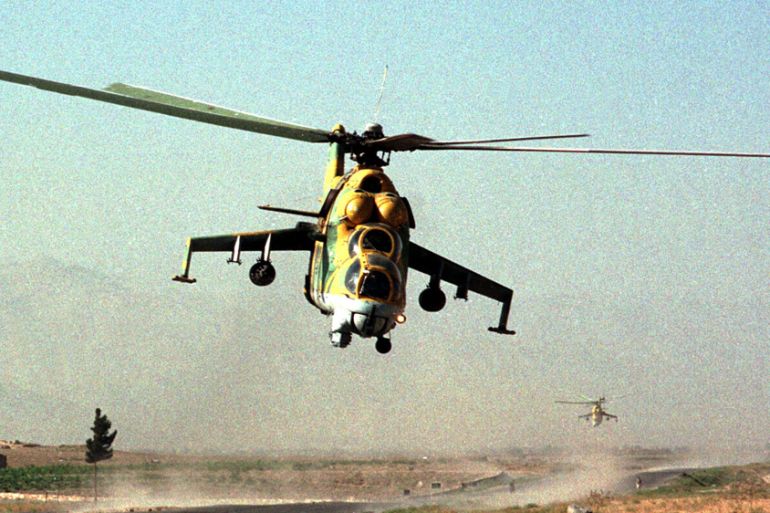Analysis: Russian gunships replace jets in Syria
While Russia announced a major withdrawal of its military might last month, the opposite appears to have taken place.

Russian President Vladimir Putin surprised the world by abruptly declaring on March 15 that Russia was withdrawing its forces from Syria in the wake of a partial ceasefire deal between regime forces and certain moderate opposition groups.
For the next few days the global media was treated to impressive footage of Su-25 attack jets, Su-24 bombers and powerful Su-34 fighter bombers steaming out of their Syrian base of operations at Latakia and returning to Russia to a rapturous reception from families of the crews and the public.
Keep reading
list of 4 itemsAustin confirms Russians deployed to airbase housing US military in Niger
What’s next as ‘heavy-handed’ US negotiates pullout from Niger?
Putin says ‘radical Islamists’ behind Moscow concert hall attack
Lumbering Antonov transport aircraft flew repeated sorties back and forth between Russia and Latakia at the same time, extracting material and personnel associated with the fighter bomber squadrons.
However, as has become abundantly clear, far from being a true withdrawal or drawdown, more equipment and personnel were brought back to Syria from Russia on the return leg of these transport flights than were taken out.
|
|
What has changed is the force mix and capabilities Russia is now deploying to support President Bashar al-Assad’s war effort. The combat-proven Mi-35 Hind helicopter gunship detachment has seen its numbers increased, while the more modern Mi-28 Havoc and state-of-the-art Ka-52 Alligator have joined the fight for the first time.
While the air-superiority-focused Su-30 and Su-35S fighters remain – along with some of the Su-24 bomber aircraft – the fixed-wing contingent of Russia’s air campaign has seen its firepower substantially reduced since mid-March.
With the ceasefire between Assad and moderate rebel forces around Aleppo mostly holding for now, fighting has shifted towards the actual stated aim of Russia’s original intervention – Islamic State of Iraq and the Levant (ISIL, also known as ISIS).
The recent recapture of Palmyra from ISIL is an impressive achievement for the Syrian army and Russian air and technical support. In the more mobile warfare around Palmyra, low-flying helicopter gunships are more effective and militarily relevant than they were during operations against besieged moderate opposition-held cities.
By contrast, the indiscriminate Russian carpet bombing with unguided missiles and cluster munitions – conducted against rebel-held cities in support of Assad’s offensives around Aleppo and elsewhere – have less psychological and tactical value against mobile ISIL forces fighting in open territory.
It therefore makes sense for Russia to increase its forces with helicopter gunships as opposed to fighter jets.
There is increased risk, however, that more Russian aircrew might be lost since even modern low-flying helicopters are at risk from the plentiful shoulder-fired anti-aircraft missiles (MANPADS) used by various rebel groups in Syria.
READ MORE: Syria’s war – a showroom for Russian arms sales
The Mi-28 Havoc is roughly analogous to the US-made AH-64 Apache helicopter, which has been a mainstay of Western operations in Iraq and Afghanistan. It is well suited for close air support for Assad’s ground forces in relatively open terrain, being able to remain on station for longer than a fighter jet and repeat attacks more frequently with missiles, rockets, and cannon fire.
The Ka-52 Alligator, meanwhile, is a more unconventional aircraft with double sets of main rotor blades mounted on top of each other and no tail rotor.
This gives it advantages over conventional helicopters in terms of speed, power-to-weight ratio, and damage resistance. Its appearance in Syria – the first combat use of its type – is noteworthy for two reasons.
First, as with the use of air superiority fighters, stealth cruise missiles, and the latest T-90M tank model, it is another example of Russia’s tendency to use Syria as an opportunity to showcase as many of its advanced systems for the export market as possible, even where not militarily necessary.
Secondly, it suggests that Russia’s special forces presence on the ground in Syria is increasingly kinetic. This is because while the Mi-28 is intended to be the Russian regular army’s standard attack helicopter, the Ka-52 is specifically assigned to the Russian special forces as their organic air support.
Despite Russia’s stated intention to withdraw the majority of its forces from Syria, the drawdown of the fixed-wing jet presence has masked an overall build-up that has seen the latter replaced with helicopter gunships.
What remains strange is that Putin is not making greater political use of the achievements of his combat forces in Syria, now that they are genuinely taking a lead in fighting ISIL – with notable success – rather than bombing Western-backed moderate rebel forces in besieged cities.
Justin Bronk is a Research Fellow in Military Sciences at the Royal United Services Institute
The views expressed in this article are the author’s own and do not necessarily reflect Al Jazeera’s editorial policy
|
| |
|